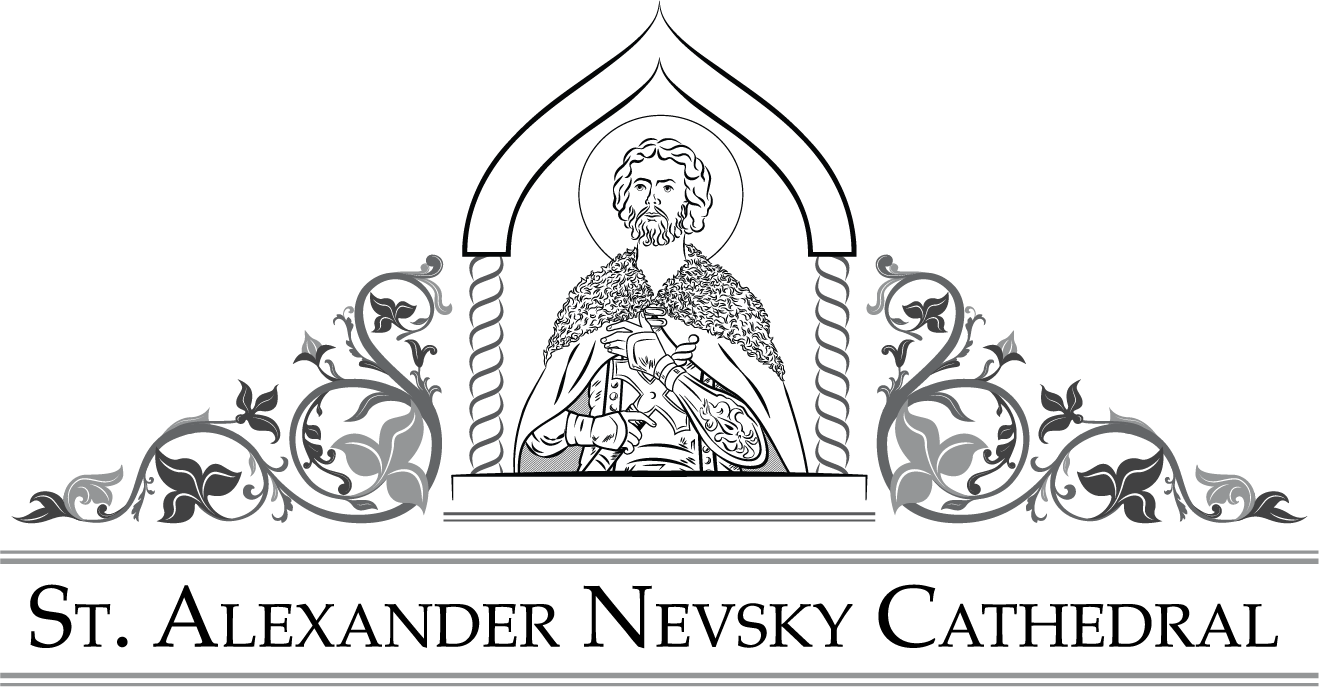St. Alexander Nevsky Cathedral
Our Lady of Tikhvin Church
St. George's Church
Dear Parishioners & Friends,
Every year, when we celebrate Holy Pentecost, we pray to the Holy Spirit to fortify us and rejuvenate our souls. It is never too late for us to make a new beginning in our spiritual lives, starting with the way we attend the services! By coming on time. By confessing and receiving Holy Communion on a regular basis. By educating ourselves about the meaning and importance of the services. If we can instill this into ourselves and our children, what great spiritual benefit we could attain! How pleasing to God we would be! Through this, we can enhance our spiritual life, and, together, as a parish family, attain the heavenly kingdom.
Welcoming You to St. Alexander Nevsky's

When visiting our parish for the first time, please remember that, regardless of whether or not you are an Orthodox Christian, we are very honored by your visit and happy to meet you. When you visit us, we are anxious to meet and receive you as our guest; so feel free to quietly introduce yourself to the candle counter staff when you enter the church, and you are also welcome to introduce yourself to the priest at the end of the service during the kissing of the Cross.
The Church Building
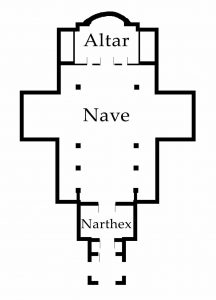 On your visit, you will note two things immediately. The first is that the church is divided into three distinct spaces, which are called the narthex (the first space where the candle counter is located), the nave (the centermost part of the church), and the altar, or sanctuary (where the Altar Table and Table of Oblation are located). The narthex was traditionally where catechumens and penitents would remain; in modern practice, it is where the exorcism prayers at baptisms are read, betrothals at weddings and churchings are performed, and where candles are sold. The nave represents the world, sanctified by God’s presence and the mighty acts He has performed for our salvation. For this reason, we see icons here celebrating the major feasts of the Church year and icons of various saints. The altar represents the Kingdom of God, and the Altar Table proper represents His Throne. Here the Mysteries, or Sacraments, of the Faith are celebrated, and from this Table, the central most Sacrament of the Church, the Eucharist, is offered.
On your visit, you will note two things immediately. The first is that the church is divided into three distinct spaces, which are called the narthex (the first space where the candle counter is located), the nave (the centermost part of the church), and the altar, or sanctuary (where the Altar Table and Table of Oblation are located). The narthex was traditionally where catechumens and penitents would remain; in modern practice, it is where the exorcism prayers at baptisms are read, betrothals at weddings and churchings are performed, and where candles are sold. The nave represents the world, sanctified by God’s presence and the mighty acts He has performed for our salvation. For this reason, we see icons here celebrating the major feasts of the Church year and icons of various saints. The altar represents the Kingdom of God, and the Altar Table proper represents His Throne. Here the Mysteries, or Sacraments, of the Faith are celebrated, and from this Table, the central most Sacrament of the Church, the Eucharist, is offered.
The second thing you will notice is the icon screen (called the “iconostas” or “iconostasis”), which separates the altar from the nave. On this screen, you will see icons of Christ, the Mother of God (called “Theotokos” or “Panagia” in Orthodox tradition), our patron St. Alexander Nevsky, and several other saints.
Much has been written about this screen and the separation it causes; some view this separation as a barrier to prayer. In the Orthodox tradition, however, it is generally not understood in this way. Rather, the iconostasis makes “visible” that which would remain invisible even if the screen were to be removed. Since, as created beings, we cannot cross the gulf between creature and Creator, we must rely on a negative (or “apophatic”) theology that recognizes and affirms this inability to positively disclose God’s being. Much like Elijah on Mount Horeb, we are brought to recognize that there are aspects of God that we cannot see face-to-face. We can experience His presence, however – His divine “energies” – and it is this experience that the iconostasis seeks to foster by directing our focus and attention.
At the center of the iconostas are the Holy or Royal Doors, which are opened during the celebration of the Divine Liturgy and at other times when the clergy enter the altar area. Immediately beyond these doors stands the Altar Table, on which are placed the Holy Gospel, the Hand- Cross, and the Tabernacle. It is worth noting that the presence of the Holy Gospel on the Altar Table is not simply for convenience, as the Gospel is read during the Liturgy: its presence on the Altar Table illustrates our understanding that, although all can read the Gospel privately, it is only in the Church’s reading and proclamation of this good news that its true meaning and interpretation can be found. The Liturgy, then, forms the context in which the Gospel – and, by extension, all of Holy Scripture – finds its place as part of Holy Tradition, and is not separate or opposed to it.
The iconostasis and all of the icons in the church form a theological mosaic of sorts. With the hymnography, liturgical music, bells, vestments, church architecture, and all of our liturgical arts, these creaturely forms celebrate and communicate God’s entrance into the “flesh” of our world.
Entering the Church
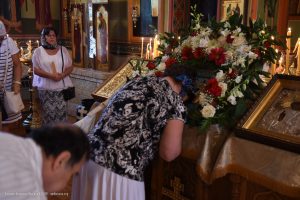 Upon entering the church, Orthodox Christians usually pause in the narthex to purchase candles and to list the names of their friends and relatives, both living and deceased, whom they wish to have commemorated at the service. Then they will enter the nave and proceed to venerate the icons that are held on icon stands, called “analogion” or “analoi” stands. These are narrow, chest-high wooden stands on which smaller icons of Christ, the Theotokos, and various saints rest, to the right and left of the iconostasis. To venerate an icon means to cross oneself and bow before the icon, twice, then to reverentially kiss the icon, and then to cross oneself and bow a third time. It is customary to venerate each icon, starting on the right side of the nave, and slowly moving from icon to icon across the church to end on the left side. It is not customary in our church to approach and venerate the icons that are on the iconostasis or the frescoes painted on the walls.
Upon entering the church, Orthodox Christians usually pause in the narthex to purchase candles and to list the names of their friends and relatives, both living and deceased, whom they wish to have commemorated at the service. Then they will enter the nave and proceed to venerate the icons that are held on icon stands, called “analogion” or “analoi” stands. These are narrow, chest-high wooden stands on which smaller icons of Christ, the Theotokos, and various saints rest, to the right and left of the iconostasis. To venerate an icon means to cross oneself and bow before the icon, twice, then to reverentially kiss the icon, and then to cross oneself and bow a third time. It is customary to venerate each icon, starting on the right side of the nave, and slowly moving from icon to icon across the church to end on the left side. It is not customary in our church to approach and venerate the icons that are on the iconostasis or the frescoes painted on the walls.Language of the Services
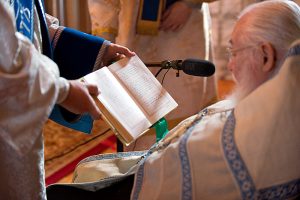 One of the first things that may strike you during our services is the language. The divine services at St. Alexander’s are solemnly carried out in Church Slavonic (an ancient form of Russian which is used in the Russian, Ukrainian, Serbian, Bulgarian, and other Orthodox Churches, similar – though not identical – to the use of Latin by Catholics) and English. We try very hard to preserve our cultural heritage through the use of Church Slavonic, but understand that there is a growing number of non-Russian speakers in the parish. For this reason, we try to perform the services bilingually, so that everyone can experience the beauty and fullness of our Orthodox Faith. English translations of the Divine Liturgy are available for complimentary use during the services, so just ask one of our friendly staff at the candle counter. If you would like more comprehensive translations of any particular service, please do not hesitate to ask one of the clergy, and they will always be more than happy to assist you. We do not want anyone to feel alienated because they cannot understand the service.
One of the first things that may strike you during our services is the language. The divine services at St. Alexander’s are solemnly carried out in Church Slavonic (an ancient form of Russian which is used in the Russian, Ukrainian, Serbian, Bulgarian, and other Orthodox Churches, similar – though not identical – to the use of Latin by Catholics) and English. We try very hard to preserve our cultural heritage through the use of Church Slavonic, but understand that there is a growing number of non-Russian speakers in the parish. For this reason, we try to perform the services bilingually, so that everyone can experience the beauty and fullness of our Orthodox Faith. English translations of the Divine Liturgy are available for complimentary use during the services, so just ask one of our friendly staff at the candle counter. If you would like more comprehensive translations of any particular service, please do not hesitate to ask one of the clergy, and they will always be more than happy to assist you. We do not want anyone to feel alienated because they cannot understand the service.Standing vs. Sitting
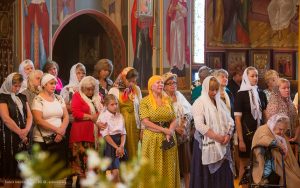 During liturgical services and except at certain times, such as during a sermon or while announcements are made following the Liturgy, those gathered will usually stand and not sit. Standing for prayer may strike Western Christians as peculiar, since in the Western tradition, Christians often sit or kneel to pray. But in thinking about it, even in conventional life we will often stand when we are engaged in any serious activity. One would never think to sit when in the presence of a King or Queen, for example, so why would we take the liberty of sitting when in the presence of God? Thus, when you visit our church, be prepared to stand during the services, unless you are unable to do so for reasons of health. In this case, you will see that we do have benches along the walls of the nave, and if you need to, you should use them without feeling any embarrassment.
During liturgical services and except at certain times, such as during a sermon or while announcements are made following the Liturgy, those gathered will usually stand and not sit. Standing for prayer may strike Western Christians as peculiar, since in the Western tradition, Christians often sit or kneel to pray. But in thinking about it, even in conventional life we will often stand when we are engaged in any serious activity. One would never think to sit when in the presence of a King or Queen, for example, so why would we take the liberty of sitting when in the presence of God? Thus, when you visit our church, be prepared to stand during the services, unless you are unable to do so for reasons of health. In this case, you will see that we do have benches along the walls of the nave, and if you need to, you should use them without feeling any embarrassment.Venerating Icons
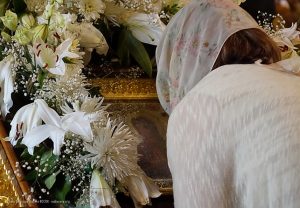 The practice of venerating icons is very old and is central to the piety of Orthodoxy. In the West, this custom may also seem peculiar and, indeed, much attention has been given to the question of whether such veneration is idolatry. However, no Orthodox Christian would ever consider this practice to be a form of idolatry. Icons, like relics of the saints and the Gospel book itself, are always offered for veneration as a sign of the love and respect that we have for God and for His action, His Incarnation, in the created and material world. As a result of His Incarnation, we can picture God; indeed, we are made in His image, and the icons of all of the saints are thus simply images of their participation in the divinized humanity of Christ. They are the signposts along the road of the Christian life, pointing the way for us to go. When we venerate icons of the saints, we prostrate before their earthly struggles that have glorified them in the Heavenly Kingdom, and ask for their intercession before the Lord. Specific prayers in various times of need can be offered to specific saints. For example, St. Nicholas is the patron saint of travelers, and it is customary for Orthodox Christians to pray to him before the start and upon completion of any journey. St. Nektarios of Aegina is the patron saint of cancer patients, St. George the Trophy-Bearer is the patron saint of soldiers, and so on.
The practice of venerating icons is very old and is central to the piety of Orthodoxy. In the West, this custom may also seem peculiar and, indeed, much attention has been given to the question of whether such veneration is idolatry. However, no Orthodox Christian would ever consider this practice to be a form of idolatry. Icons, like relics of the saints and the Gospel book itself, are always offered for veneration as a sign of the love and respect that we have for God and for His action, His Incarnation, in the created and material world. As a result of His Incarnation, we can picture God; indeed, we are made in His image, and the icons of all of the saints are thus simply images of their participation in the divinized humanity of Christ. They are the signposts along the road of the Christian life, pointing the way for us to go. When we venerate icons of the saints, we prostrate before their earthly struggles that have glorified them in the Heavenly Kingdom, and ask for their intercession before the Lord. Specific prayers in various times of need can be offered to specific saints. For example, St. Nicholas is the patron saint of travelers, and it is customary for Orthodox Christians to pray to him before the start and upon completion of any journey. St. Nektarios of Aegina is the patron saint of cancer patients, St. George the Trophy-Bearer is the patron saint of soldiers, and so on.Holy Sacraments
The most important Sacrament in the Orthodox Church is the Holy Eucharist (Holy Communion). Only Orthodox Christians may participate in Holy Communion. If you are interested in finding out more about the Orthodox Faith, please do not hesitate to speak to one of our clergymen.
Dressing Appropriately
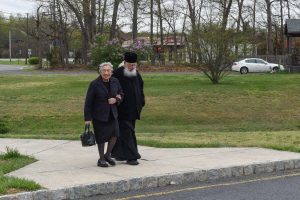 Even though Orthodox Christians feel comfortable in church, they still tend to show respect by the way they dress and how they conduct themselves when they attend services or just enter a church. We generally try to retain the old custom, by which the men and women stand on opposite sides of the church (women on the left, men on the right, as you enter). Women should cover their heads and wear skirts or dresses of at least knee-length. We generally try to avoid wearing anything that is distracting, and this practice applies to both men and women. For example, we would avoid wearing clothing that is revealing, distracting, or too casual: we try to wear clothing that is dignified and shows respect toward God. We do not wear revealing clothes, shorts, clothes that have words or logos emblazoned on them, sports uniforms, bathing attire, anything that is likely to catch someone’s attention and distract them from prayer. So, if you wouldn’t wear it to a business meeting, you can pretty much be sure that you shouldn’t wear it to church, either. However, it is important to understand that our external appearance is secondary when we come before the Lord. It is far more important to come to church with an open and penitent heart than in proper attire.
Even though Orthodox Christians feel comfortable in church, they still tend to show respect by the way they dress and how they conduct themselves when they attend services or just enter a church. We generally try to retain the old custom, by which the men and women stand on opposite sides of the church (women on the left, men on the right, as you enter). Women should cover their heads and wear skirts or dresses of at least knee-length. We generally try to avoid wearing anything that is distracting, and this practice applies to both men and women. For example, we would avoid wearing clothing that is revealing, distracting, or too casual: we try to wear clothing that is dignified and shows respect toward God. We do not wear revealing clothes, shorts, clothes that have words or logos emblazoned on them, sports uniforms, bathing attire, anything that is likely to catch someone’s attention and distract them from prayer. So, if you wouldn’t wear it to a business meeting, you can pretty much be sure that you shouldn’t wear it to church, either. However, it is important to understand that our external appearance is secondary when we come before the Lord. It is far more important to come to church with an open and penitent heart than in proper attire.Conversing During Services
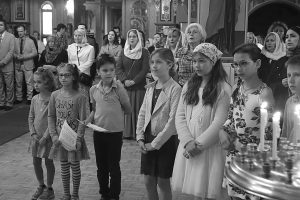 In line with showing respect and not causing a distraction to those praying around us, we must avoid unnecessary conversation in church. As we see those we know, we may quietly and briefly greet each other in joy, while always being aware of what is happening at that time in the service. There are certain times when absolute silence and prayerful concentration should be maintained, such as during the reading of the Gospel, during the Cherubic Hymn and the Eucharistic Canon (which is the most solemn part of the service, immediately after the singing of the Symbol of Faith), as well as during the time immediately before Holy Communion when the clergy is communing and the faithful are preparing themselves to do so. It is also important to show respect and courtesy by attentively listening to the sermon and at other times when the priest is speaking.
In line with showing respect and not causing a distraction to those praying around us, we must avoid unnecessary conversation in church. As we see those we know, we may quietly and briefly greet each other in joy, while always being aware of what is happening at that time in the service. There are certain times when absolute silence and prayerful concentration should be maintained, such as during the reading of the Gospel, during the Cherubic Hymn and the Eucharistic Canon (which is the most solemn part of the service, immediately after the singing of the Symbol of Faith), as well as during the time immediately before Holy Communion when the clergy is communing and the faithful are preparing themselves to do so. It is also important to show respect and courtesy by attentively listening to the sermon and at other times when the priest is speaking.Children in the Church
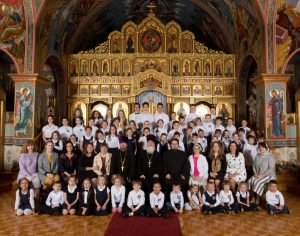 Children are just as much a part of Orthodox worship as adults; in fact, Western Christians may be surprised to see that Orthodox Christians of all ages, even newborn infants, receive Holy Communion. Here at St. Alexander’s, we greatly value and cherish our youngest parishioners and visitors, whose future lies in the Church. All children – even the youngest ones – for their spiritual growth and physical safety, must be taught to stand quietly with their parents during the service. Keep in mind that children benefit no less than adults from participating in worship and by receiving Holy Communion! Families should stand and pray together off to the side and not in the center of the church. Help your children to take part in the service by encouraging them to make the sign of the cross when appropriate, sing Otche Nash and say a prayer before Holy Communion. Parents should accompany their young children to Holy Communion and, of course, all should be standing together at the front of the church after communing and taking zapivka for the final appearance of the Holy Chalice!
Children are just as much a part of Orthodox worship as adults; in fact, Western Christians may be surprised to see that Orthodox Christians of all ages, even newborn infants, receive Holy Communion. Here at St. Alexander’s, we greatly value and cherish our youngest parishioners and visitors, whose future lies in the Church. All children – even the youngest ones – for their spiritual growth and physical safety, must be taught to stand quietly with their parents during the service. Keep in mind that children benefit no less than adults from participating in worship and by receiving Holy Communion! Families should stand and pray together off to the side and not in the center of the church. Help your children to take part in the service by encouraging them to make the sign of the cross when appropriate, sing Otche Nash and say a prayer before Holy Communion. Parents should accompany their young children to Holy Communion and, of course, all should be standing together at the front of the church after communing and taking zapivka for the final appearance of the Holy Chalice!We are very blessed to have many children attending church, and we love them dearly! Children must not run back and forth in the nave or go to the restroom or downstairs unsupervised. Young children who need a break may be taken downstairs by a parent or other responsible adult if necessary. Under no circumstances are children allowed to be outside, downstairs or in the narthex unsupervised. Please do not allow your children to climb around the candlestands, the Crucifix or the two large icon kiots (frames) housing the Mother of God and Christ, where there is delicate and expensive woodwork and gold leafing. This is both dangerous to their safety and inappropriate behavior.
Our parish also has a Saturday parish school for our future generations, where children are taught the Law of God, Russian grammar and history. For more information visit our parish school website: http://stalexanderparishschool.org
Our Parish Churches
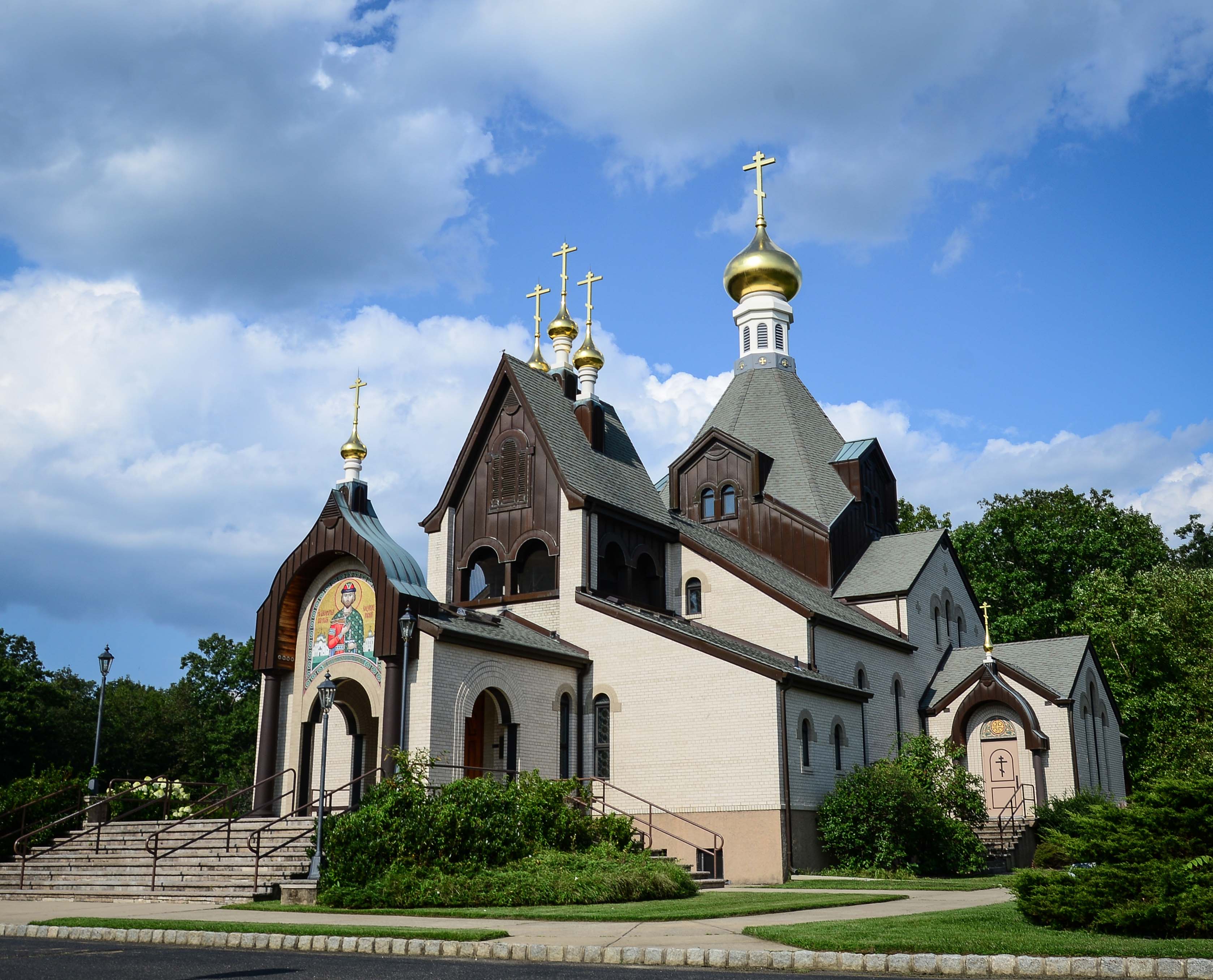
St. Alexander Nevsky Cathedral
Howell, NJ 07731
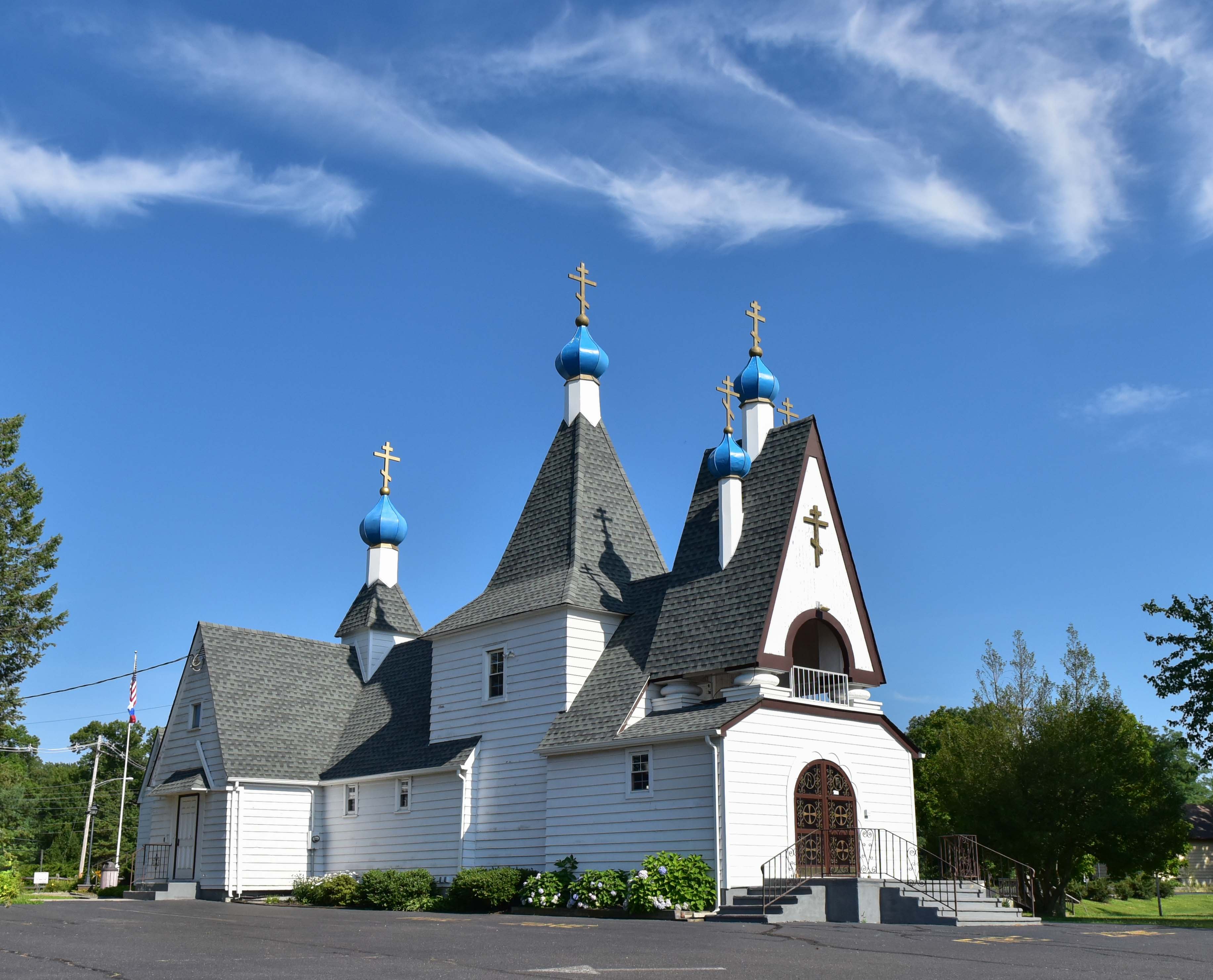
Our Lady of Tikhvin Church
200 Alexander Avenue
Howell, NJ 07731
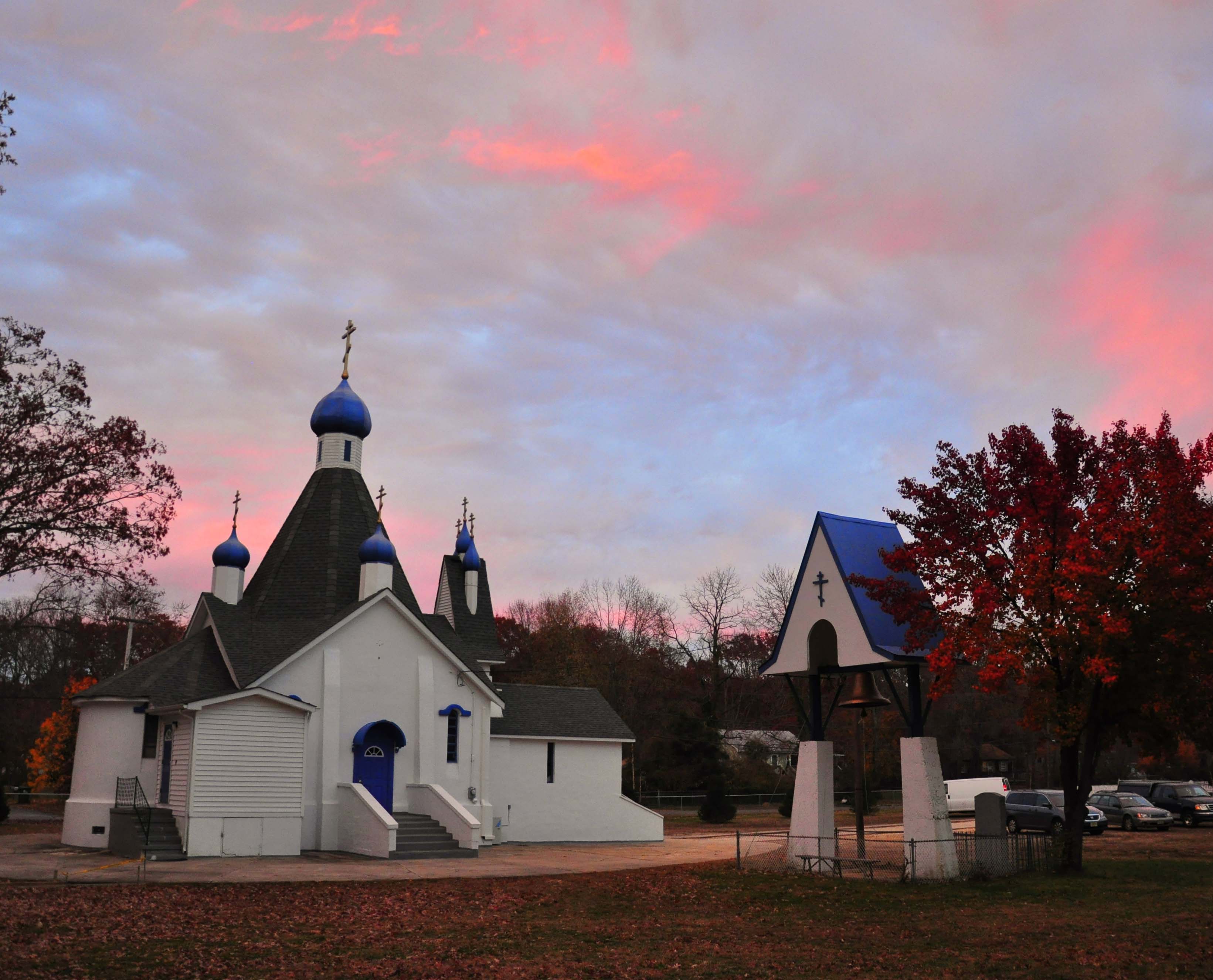
St. George's Church
57 East 3rd Street
Howell, NJ 07731
